Baking tips
Temperature – Part 1 – December 2022
It’s a cold crisp morning here with frost and ice outside on the grass and hedgerows, there’s a fire in the oven to try and raise the temperature of the Bakehouse a few degrees. As well as firing the oven for baking, I’m using the fire as a source of heat to maintain a warm dough temperature during the bulk fermentation. This will help me to achieve good volume and a nice soft open crumb in my loaves which is what I’m always aiming for.
During the warmer months of the year, when we have an ambient room temperature above 20°C, our sourdough breads can seem relatively easy to make. Our starters and levains are full of life; with bubbles of gas popping and they have a sweet scent and flavour. The warm dough needs minimum maintenance after mixing, it rises and when baked produces the most delicious of foods. However, during winter this can be a little more difficult to achieve, so we must bring our attention to Temperature. A simple kitchen wall thermometer and a kitchen probe thermometer will really help us to understand and control these temperatures.
Temperature is a broad subject and is central to all aspects of baking and ensuring successful natural fermentation of flour to produce delicious sourdough breads. So I’m going to break it down into a few areas and focus on these separately.
These areas are:-
– controlling the starter and levain
– correct dough temperature for a nice soft open crumb
– the oven temperature
– knowing when your loaf is fully baked
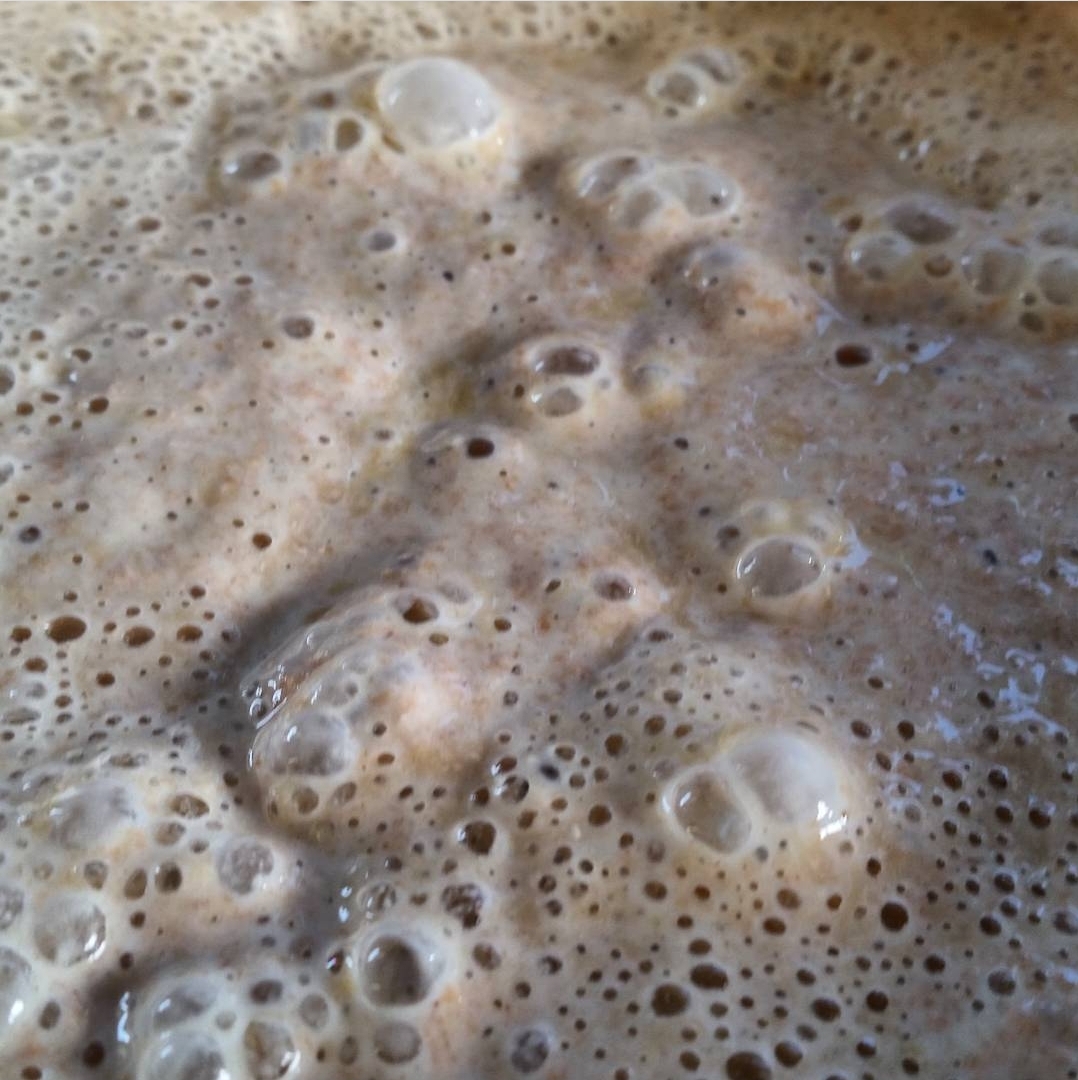
Controlling the starter and levain
Before jumping into using heat to get our starters and levains fermenting, we’ll take a look at cold.
If you are not using your starter on a daily basis, leave it in the fridge. Anyone who has participated in one of our Sourdough Classes in our Bread School will have looked at, smelled and tasted some 20 year-old sourdough starters: a wholemeal rye sourdough starter and a strong white flour starter which have been left in the fridge without being refreshed for 5 months. As a result of being left this long, both starters have separated into different layers: the top layer is very strong vinegar, the second layer is a blackish layer of sediment and then there’s a layer of thick fermented flour at the bottom. When we taste a tiny sample of the rye starter, balsamic vinegar immediately comes to mind.
These starters are absolutely fine. Within a week of refreshments, they will be bubbling up and be ready to produce beautiful loaves. One note of caution, if you taste your starter and it tastes disgusting (!), as if it has gone off and is rotten, throw it out.
We will do a deeper dive into storing and refreshing sourdough starters and levains with different inoculation rates on another deep dive. At this stage, I just want to bring some attention to storing your starter in the fridge when not in use. If it is strong and healthy, it will be fine. There is no need to be overfeeding, discarding and wasting unneeded starter. It will take a few refreshments to get it lively again but a wholemeal rye starter can usually be left in the fridge for a week then taken out and refreshed to build your levain 10-14 hrs before you wish to bake and should be hitting those ‘sweet spots’ right on time.
A starter made from strong white flour should last about 5 days in the fridge and can be refreshed once before using. Once the starters are out of the fridge and warm up, they will begin to ferment.
To achieve a nice soft open crumb in our sourdough breads, it’s much easier if our levains are in their ‘sweet spots’ (as described in our free ebook ‘The Sourdough Starter Cycle’, available when you join our online baking community).
Most home bakers and some professional bakers (including myself), don’t have proving chambers where we can control the air/room temperature for the fermentation of our starter/levain. We work with whatever the room temperature is. So for us to achieve the correct temperature for our levain to ferment, we vary the temperature of the water we use to refresh it with.
To develop a good understanding of why and how to get your levain into the ‘sweet spots’ refer to our ‘Sourdough Starter Cycle’ ebook.
Here’s a little guide to approximate water temperatures for refreshing our starters and building our levains, for various room temperatures. Cooler water will lead to a longer fermentation time, warmer water a shorter fermentation time. Compared to strong white flour, rye flour can tolerate and require a longer fermentation time at a higher temperature.
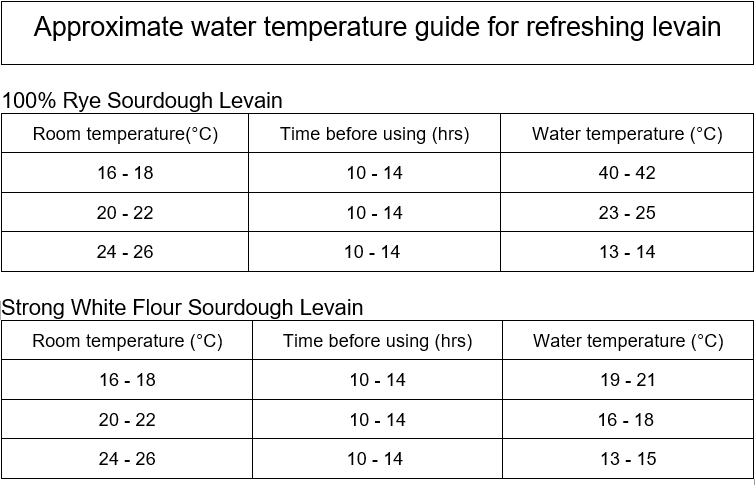
If you have taken your starter straight out of the fridge, add another 15°C to all the above water temperatures.
Correct dough temperature for a nice soft open crumb
Getting your dough temperature to 25°C-26°C for the bulk fermentation stage (that’s the stage after me have mixed the dough and before we shape it) will go a long way to helping you achieve a nice soft open crumb in wheat based breads and also help prevent ‘tunnelling’ and ‘pancaking’.
‘Tunnelling’ is caused when under-fermented dough is baked off too early. The dough rises rapidly in the oven and when you cut into the finished loaf there are large holes running the length on the loaf, with a tight crumb between these holes.
‘Pancaking’ is where the dough is more extensible than wanted and the dough spreads in the oven.
Most of us will have experienced these two common errors at some point in our baking lives.
Achieving accuracy with our Desired Dough Temperature (DDT) relies on a number of factors. Most of these factors we have very little control over:
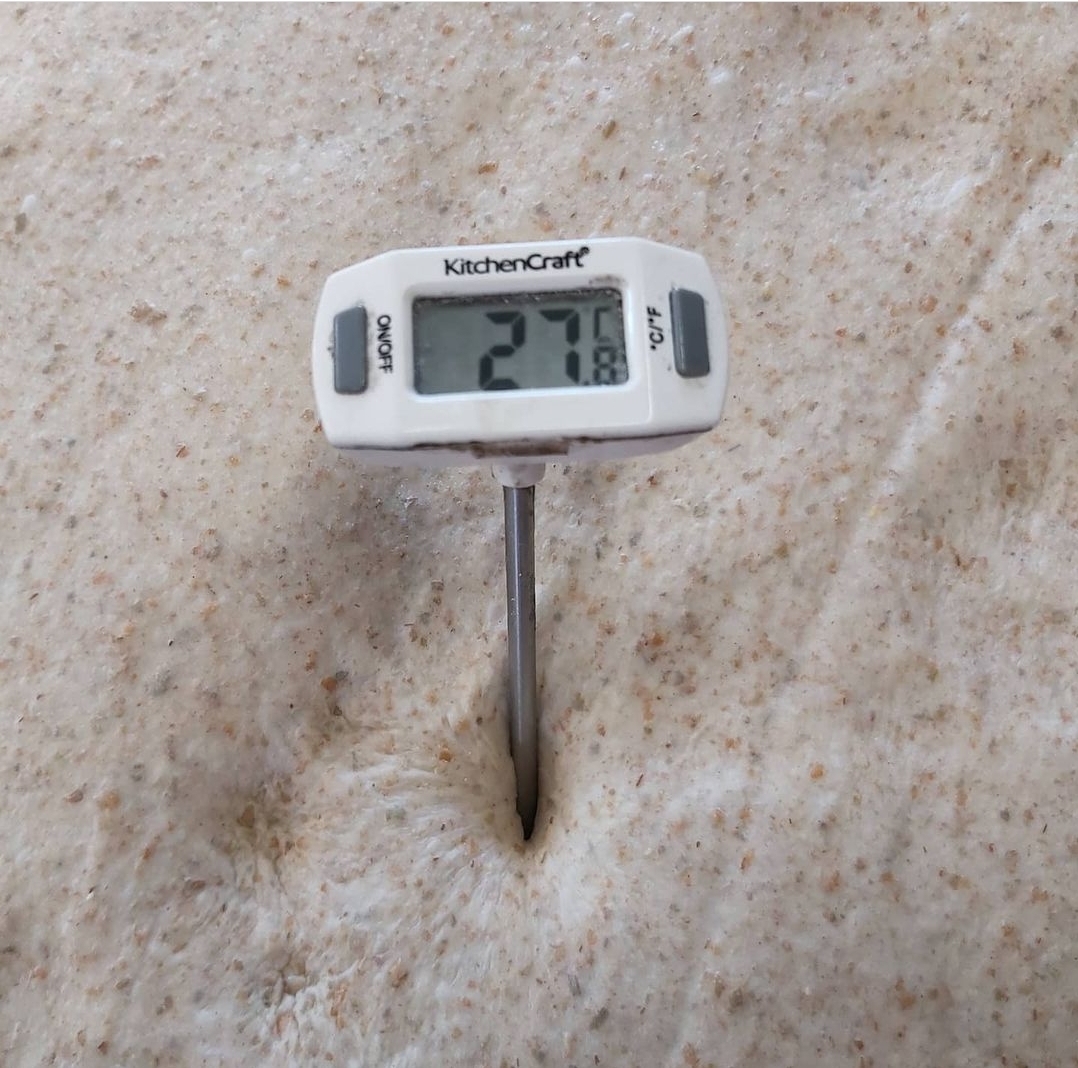
room temperature
flour temperature
levain temperature
soaker temperature if adding soaked seeds or grains
friction factor (if using a mixer)
Water temperature is the factor within our control. We can use this ability to control to achieve our Desired Dough Temperature (DDT).
As our dough will be fermenting at room temperature, if the room temperature is above or below 25°C/26°C, the dough will either warm up or cool down as it ferments. In which case our DDT will be lower or higher than 25°C/26°C, so that the temperature of the dough passes through this temperature range during the bulk fermentation.
Even in very cold conditions, if you are using a mixer I don’t recommend aiming for a Desired Dough Temperature above 28°C, unless you are very experienced in controlling the strength and extensibility of your dough during mixing. Above 30°C, the dough can become very extensible and it can affect the final loaf quality. In this case, we are better off giving a longer bulk fermentation time, so that we still build volume in the dough before shaping.
See below, a very simple guide for Desired Dough Temperature at various room temperatures

If using a mixer to develop your dough, one consideration is the Friction Factor (FF). That is the amount of heat added to the dough during mixing.
I have a large spiral mixer with a dough hook and this adds approximately 2°C to the dough temperature when I am mixing most of my doughs.
Due to this extra 2°C, I will be aiming for an Initial Dough Temperature (IDT) 2°C less than my DDT.
To work out what the Friction Factor of your mixer is: take the temperature of the dough just after it has been brought together in the mixer. Then mix your dough until there is a good amount of strength developed. Take the temperature again. The difference between the Initial Dough Temperature and the Final Dough Temperature is your Friction Factor:
IDT – FDT = FF
As stated earlier, we can achieve our DDT by varying our water temperature. Our water temperature is thus calculated by
WT = (DDT x Number of Known Factors) – each of the known factors
Here are a couple of examples of calculating the water temperature for different breads, one with and one without a soaker:
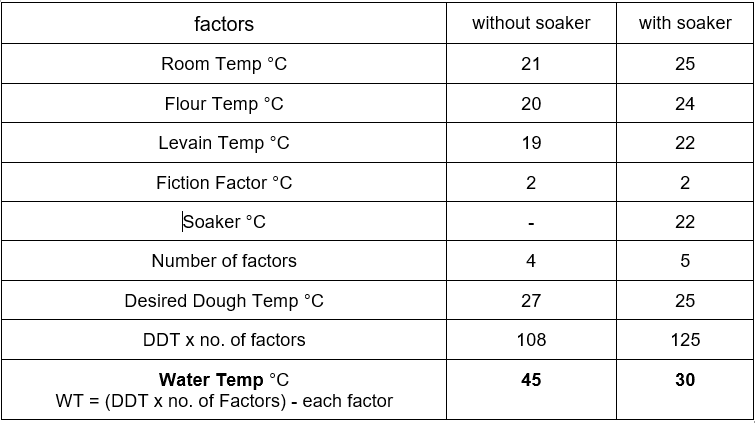
Hope you found this useful and please comment on this topic below. You can subscribe to our online baking community to send your baking queries and suggestions for future topics to Joe.
In part two of our deep dive into temperature, we will talk about the oven temperature and knowing when your loaf is fully baked.
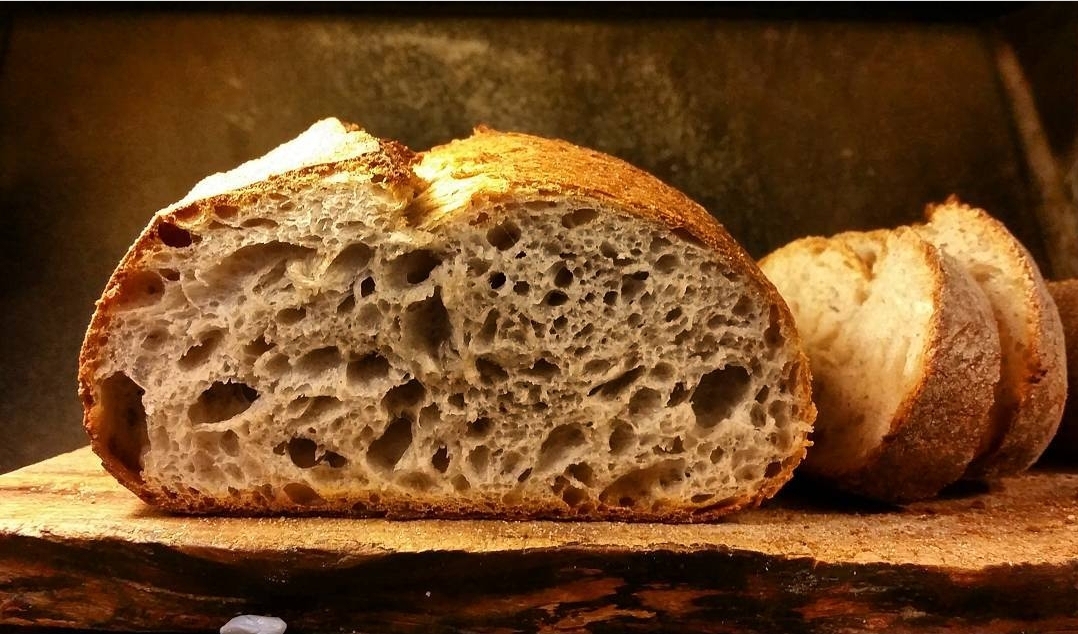
Dear bakers
Subscribe to our online baking baking community and you can send your baking queries to Joe.
He’ll respond to a selection of questions each month on this page.
If you have found our baking tips valuable and would like to further support Riot Rye’s work in building a baking community, you can donate here.
We wish you well with your baking!
Julie & Joe

Leave A Comment